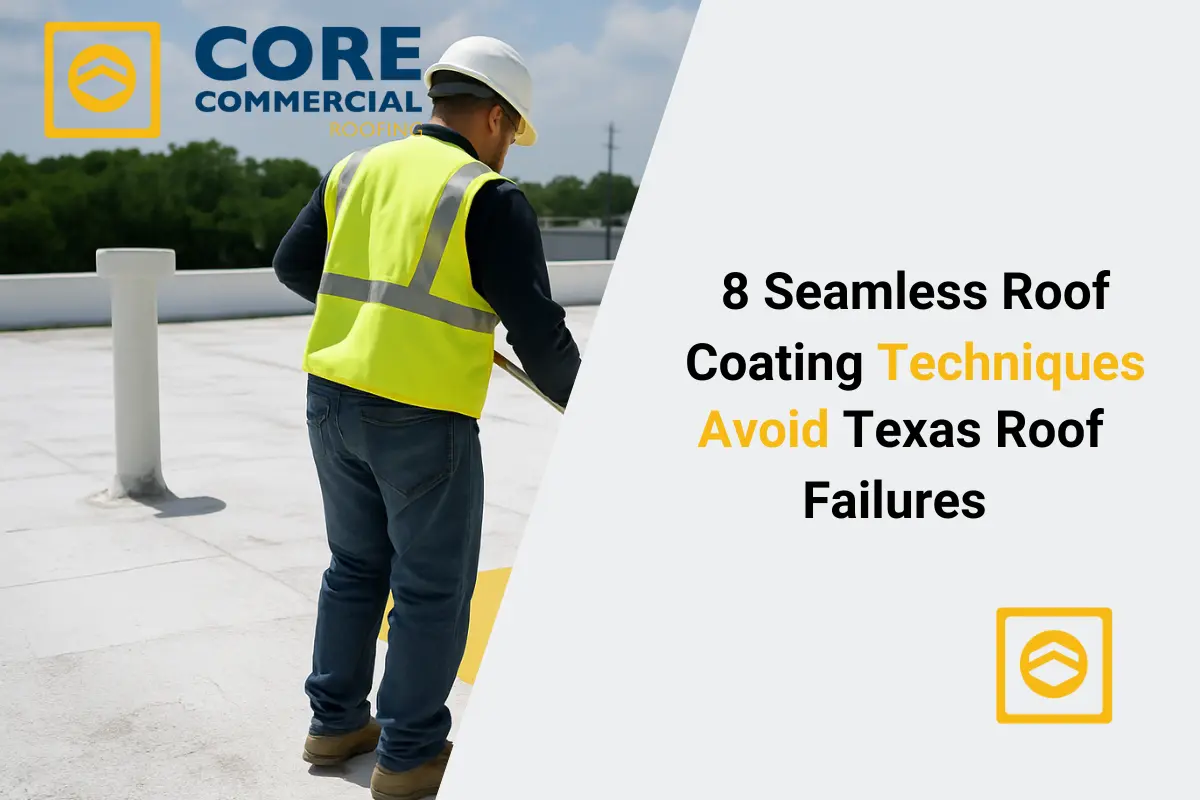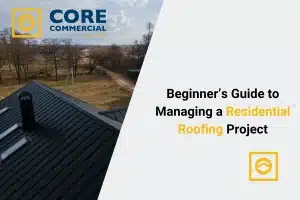Texas roofs face some of the harshest conditions in the country: scorching sun, sudden hailstorms, strong winds, and long periods of rain. Over time, even small cracks or worn edges can lead to costly roof failures if not addressed. That’s why seamless roof coatings are more than just an upgrade; they’re a necessity for long-lasting roof protection. Done right, they help stop leaks, cut down on heat absorption, and extend the life of your roof by up to 10–15 years. But not all coating jobs are equal.
One of the most essential techniques is proper surface preparation using pressure washing. Without it, even the best coatings will fail to bond and won’t last.
In this article, you’ll learn eight proven roof coating methods that make a real difference in tough Texas weather. Whether you own a home, manage a commercial building, or handle property maintenance, these techniques give you the power to protect your investment and prevent expensive future repairs. Let’s walk through each step to ensure your next roof coating is done right and built to last.

Table of Contents
Why Roof Coatings Matter in Texas
Texas roofs take a beating, especially in cities like Dallas, Houston, Austin, and San Antonio. Between scorching sun, violent hailstorms, and sudden weather swings, your roof is under constant pressure. Cracks, blisters, ponding water, and UV damage are common in Texas, and they often go unnoticed until severe leaks appear.
Applying a seamless roof coating is one of the smartest ways to protect your property. These coatings act like a flexible shield, sealing up cracks and joints, preventing leaks, and adding years of life to your roof. Done right, they can:
- Stop leaks before they start
- Reflect heat to lower cooling bills
- Reduce wear from rain, hail, and sun
- Extend the life of your roof by 10+ years
But doing it wrong—or cutting corners—can cause coatings to peel, bubble, or trap moisture, leading to bigger problems down the line.
Choosing the Right Roof Coating for Texas Weather
Texas doesn’t play around with its weather, so your coating must be tough, flexible, and UV-resistant. Some popular options include:
- Silicone Coatings – Best for ponding water and UV resistance
- Acrylic Coatings – Ideal for high reflectivity and cost-effectiveness
- Polyurethane Coatings – Great for impact resistance and durability
The best roof coating depends on your roof type, local conditions, and budget. Flat roofs may benefit from silicone, while sloped roofs might be better with acrylic. Don’t just go with what’s cheap—go with what performs in Texas.
1. Pressure Washing for Proper Surface Prep
Why it matters: Any dirt, grease, or debris left on your roof will prevent the coating from bonding properly.
Before anything goes down, the roof surface needs a deep clean. Pressure washing removes built-up grime, moss, algae, and any existing loose coatings. This creates a clean, roughened surface that helps the new coating grip better.
Tips:
- Use a rotating nozzle for even cleaning
- Allow the surface to dry completely before the next step
- Inspect for wet insulation under the roof deck
Skipping this step is like painting over mud—it won’t last.
2. Seam Sealing with Reinforced Fabric
Why it matters: Seams and joints are the first places where leaks happen.
Roofs expand and contract, and the seams take the hit. Applying a base coat and embedding polyester mesh or reinforced fabric into vulnerable areas (like seams, penetrations, and flashing edges) strengthens the roof where it’s most likely to fail.
How it’s done:
- Brush or roll a base layer of coating along seams
- Embed fabric while wet
- Apply another coat on top to lock it in
This creates a seamless barrier that flexes with temperature swings, critical for Texas.
3. Crack Bridging with Elastomeric Compounds
Why it matters: Small cracks turn into big problems during freeze-thaw or summer heat cycles.
Texas sees big temperature changes, which stress your roof materials. Elastomeric sealants are rubber-like substances that stretch and flex, making them perfect for filling cracks and covering up small holes.
Best practices:
- Fill any visible cracks over 1/16 inch
- Use a trowel-grade elastomeric for larger gaps
- Let it cure before coating over
This technique stops water infiltration and boosts the elasticity of your roofing system.
4. Priming for Adhesion and Longevity
Why it matters: Not all surfaces grip coatings the same way.
Certain roof materials like metal, EPDM rubber, or weathered bitumen need a primer to help the coating bond properly. Without it, you risk peeling or flaking in just a few seasons.
What to use:
- Acrylic primer for aged single-ply roofs
- Rust-inhibiting primer for metal roofs
- Moisture-cure primer for damp surfaces
Priming ensures the coating fuses tightly to the roof, giving you years of watertight performance.
5. Multi-Layer Application for Uniform Protection
Why it matters: One thick coat may seem faster, but it won’t perform as well as layered coats.
Apply multiple thin coats, allowing proper cure time between each layer. This ensures even coverage, avoids puddling, and helps the coating cure uniformly without trapping bubbles or moisture.
Suggested layering:
- Base coat (usually tinted)
- Mid coat (optional for extra thickness)
- Reflective topcoat (white or light-colored)
Don’t rush this. Following dry-time instructions on each product ensures durability and weather resistance.
6. Thermal Reflective Coatings for Heat Defense
Why it matters: Texas heat can turn your roof into a frying pan—and your energy bill into a nightmare.
Cool roof coatings reflect UV rays and reduce heat absorption. A white or light-colored reflective roof coating can lower rooftop temperatures by up to 50°F, cutting your cooling costs dramatically.
Benefits:
- Improved indoor comfort
- Reduced HVAC load
- Lower long-term energy costs
This also protects your roof materials from drying, cracking, and premature aging due to heat exposure.
7. Edge and Flashing Reinforcement
Why it matters: Roof edges and flashings are high-risk areas where water and wind like to sneak in.
Using an extra layer of coating and reinforcement fabric around these details helps anchor the edges and prevents peeling. Flashing should be checked for loose metal or sealant gaps before coating.
Process:
- Clean and tighten metal flashings
- Apply fabric-reinforced base coat around details
- Follow up with a topcoat over the area
This prevents wind-lift, flashing leaks, and edge damage during heavy storms.
8. Final Inspection and Moisture Scanning
Why it matters: Trapped moisture will lead to coating failure and mold growth.
Once your coating is applied, it’s time for quality control. Use infrared or moisture scanners to ensure no water is hiding under the roof layers. Even small wet areas can cause blistering, bubbles, or coating separation later.
Inspection checklist:
- Check the thickness of each layer (wet mil gauge)
- Inspect seams and flashing
- Perform a moisture test in suspect areas
This is your last chance to defend your work before the weather tests it.
Roof Maintenance Tips Post-Coating
Coating your roof isn’t a set-it-and-forget-it deal. Regular checkups keep your protection strong for years.
- Inspect twice a year, especially after storm season
- Clean drains and gutters to avoid ponding water
- Recoat every 8–10 years or as recommended by the product
If you catch small issues early, you avoid bigger repair bills later. Prevention always costs less than correction.

Conclusion: Build Peace of Mind Under a Seamless Roof
Roof problems in Texas don’t always come with warning signs. It might start with a soft spot, a heat bubble, or minor peeling—until one day, it’s a major leak.
Using these eight seamless roof coating techniques gives you more than just surface coverage. You build a flexible, energy-saving, low-maintenance system designed to perform under Texas pressure. From scorching summers to surprise storms, a well-coated roof stands its ground—and keeps what matters underneath safe.
Whether you’re managing commercial property or caring for your own home, investing in the right coating process today helps you avoid emergency repairs tomorrow. Peace of mind starts at the top—literally.
FAQs
What is the best roof coating for Texas weather?
In Texas, where the sun is strong and storms are common, silicone roof coatings are often recommended. They handle ponding water well and reflect UV rays, keeping buildings cooler. Acrylic coatings are also popular for their reflectivity and cost-effectiveness. Choosing the right one depends on your roof type and local conditions.
How can I prevent roof leaks in Texas homes?
To prevent leaks, start by cleaning your roof thoroughly. Seal all seams and cracks with reinforced fabric and elastomeric compounds. Apply a primer suitable for your roof material, then add multiple layers of coating. Regular inspections, especially after storms, help catch issues early.
Are seamless roof coatings effective in Texas?
Yes, seamless roof coatings are very effective in Texas. They create a continuous barrier without joints, reducing leak points. These coatings expand and contract with temperature changes, making them ideal for Texas’s fluctuating weather.
How many times a year should I check my roof in Texas?
It’s best to inspect your roof at least twice a year, preferably in spring and fall. After major storms, check for damage. Regular inspections help identify problems early, saving money on repairs and extending your roof’s life.
Do roof coatings help reduce energy bills in Texas?
Absolutely. Reflective roof coatings bounce back sunlight, reducing heat absorption. This keeps your home cooler, lessening the need for air conditioning and lowering energy bills, especially during hot Texas summers.
Can I apply roof coating myself in Texas?
While DIY is possible, it’s recommended to hire professionals. Proper application requires specific tools and knowledge, especially for large or commercial roofs. Professionals ensure the coating is applied evenly and adheres properly, providing long-term protection.
What are the common causes of roof leaks in Texas?
Common causes include aging roofs, missing or damaged shingles from wind or hail, clogged gutters, and poor flashing around chimneys or vents. Regular maintenance and timely repairs can prevent these issues from leading to leaks.
What’s the best way to pick a roof coating for my home in Texas?
Consider your roof type, local climate, and budget. Silicone coatings are great for flat roofs and areas with ponding water. Acrylic coatings are cost-effective and reflect sunlight well. Consulting with a roofing professional can help determine the best option for your needs.
Can I use roof coating on a metal roof in Texas?
Yes, roof coatings are suitable for metal roofs. They protect against rust, seal seams, and reflect heat. Applying a coating can extend the life of a metal roof and improve energy efficiency, which is beneficial in Texas’s hot climate.
How long do roof coatings last in Texas?
The lifespan of a roof coating depends on the type and quality of the product, as well as proper application. Generally, coatings can last 10-15 years. Regular maintenance and inspections can help maximize their lifespan.






